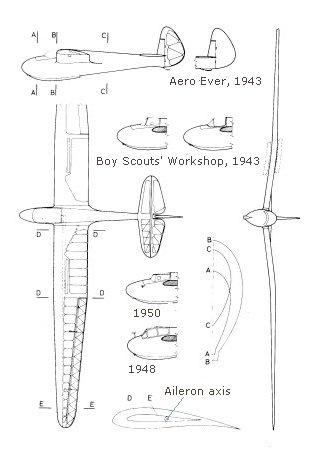HUNGARIAN GLIDERS
1933-2000
| Type designation: | M-22 |
| Name: | M-22 |
| Designer: | András SZOKOLAY - Endre JANCSÓ |
| Class: | High performance |
| General arrangement: | Middle arrenged gull wing, traditional tail unit |
| Crew: | 1 |
| First flight: | Sept. 1, 1937 |
| Manufacturer: | MSrE; Aero Ever Ltd., Aircraft Factory of Transylvania; different workshops of Aero Clubs |
| Number of built: | 20 |
.jpg)
Short history:
As technics of thermal flights progressed the MSrE (Műegyetemi Sportrepülő Egyesület - Aero Club of the Technical University) decided in the middle of the '30s to build a high performance glider. At first the Rhönbussard was selected, nevertheless after a couple of parts had been built it was decided to design a new glider. Endre Jancsó and András Szokolay with the guidance of Ernő Rubik designed a completely new glider incorporating the parts of the Rhönbussard already built.
The first glider, named Turul, was purchased by the president of the Aero Club of Egypt who happened to be on a visit to Hungary. In 1938 Edward Mole, an English flight officer, performed 147 consecutive loops with the Turul in Egypt.
Altogether 20 gliders were built. The first 3 glider were constructed at the workshop of MSrE. In 1942-43 a series of 10 were built at Aero Ever Ltd., and 4 examples were built at the Aircraft Factory of Transylvania. The other M-22s were built at different workshops of different Aero Clubs.
The glider was fully aerobatic. In Hungary the first negative loop flown with a glider was performed with an M-22. In Hungary the first 300 km cross-country was flown with an M-22 as well. The longest distance flown with M-22 was 356 km (1942) and the greatest height gain was 3845 m (1942). The first Hungarian speed record of 100 km triangle - 33,4 km/h - was also achieved by an M-22 (1948).
Structure: All wooden
Wing:
The central part of the gull form wing had a positive dihedral angle and had constant chord. The outer panels had no dihedral and were tapered with rounded wingtips. The wing in front of the main spar were constructed as a plywood covered torsion resistant box. In the line of the aileron's leading edge a light spar was fitted which run from the root to the wingtip. The glider was stressed to resist loads resulting from positive and negative pull/push out from vertical diving with a safety factor of 12. The two half wings were directly connected forming a structurally single unit. To assist low speed circling the ailerons fitted were suitable to be dropped or raised during flight.
The type originally was not fitted with airbrakes, however later versions had Göppingen type airbrakes, fitted directly behind the main spar and working on both surfaces of the wing.
Fuselage:
The cross section of the front part of the relatively short fuselage was elliptical, however behind the trailing edge of the wing the two curved halfs met in edges. The whole fuselage was covered by plywood. The pilot seat was placed partly between the wings. The main difference of the versions was the shape of the canopy. Both open and closed canopies formed by different technologies were fitted. The landing gear of the glider consisted of a rubber dumped main skid and a small tail skid of steel plate. For launching a dolly was used.
Tail unit:
The horizontal stabilizer and elevator had a tapered form with rounded tips. There were versions where a trim tab was fitted on the elevator. The leading edge of the horizontal stabilizer and rudder was plywood, all other parts of the tail unit were fabric covered.
.jpg)

.jpg)
.jpg)
